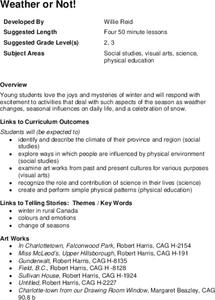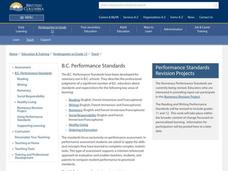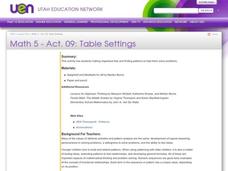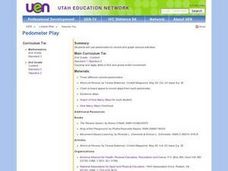Curated OER
Weather or Not!
Students are introduced to the different climate regions of Canada. In groups, they discuss ways in which people are affected by the weather and how it limits their outdoor activities. They use artwork by Robert Harris to predict what...
Curated OER
Which Animals Should Be Saved?
Fifth graders investigate the concepts related to the endangerment of different animal species. They conduct research using a variety of resources. The skills of prediction are used to show the possible outcome of the extinction of a...
Curated OER
Limiting Reagent
Students work in small groups with a small set of 8 nuts and 5 bolts to assemble into combinations of 1 nut: 1 bolt, and 2 nuts: 1 bolt. They explore the outcome and discuss. Then a student mixes two clear, colorless solutions together...
Curated OER
ANIMALS OF ANTARCTICA
Students are introduced to the animals of Antarctica and how they adapt to their environment and the changes of the seasons after being read the story,"Counting Penguins" . They pick an animal and predict how he/she thinks this animal...
Curated OER
Childhood Obesity
Students identify a question to generate appropriate data and predict results. They distinguish between a total population and a sample and use a variety of methods to collect and record data. Students create classifications and ranges...
Curated OER
Dihybrid Punnett Squares
Students construct Punnett squares to illustrate specific genotypic and phenotypic genetic outcomes.
Students calculate the probability of achieving specific genotypic and phenotypic genetic oucomes, using dihybrid Punnett squares.
Curated OER
Kinetic Vs. Potential Energy
Eighth graders listen to a teacher lecture and observe a demonstration of both potential energy and stored energy. After discussing the characteristics and examples of different types of energy, 8th graders make predictions and then...
Curated OER
The Truth Shall Set Them Free?
Students consider the notion and purpose of truth commissions, They work in groups to predict the commission's effectiveness in its efforts to promote peace and reconciliation among Liberians. Finally, students create found poems that...
Curated OER
The Human Line Plot
Fifth graders collect data and use charts and line plots to graph data. Through class surveys, 5th graders collect data concerning a particular subject. They graph their data using a line graph. Students make inferences and predictions...
Curated OER
Table Settings
Fifth graders explore and examine how to make organized lists and find patterns to help them solve problems. They identify, analyze and determine a rule for predicting and extending numerical patterns involving operations of whole...
Curated OER
Fire!, Probability, and Chaos
Students explore the concept of probability. In this probability lesson, students simulate a controlled forest burn using an applet. Students vary the probability of trees burning and predict what will happen.
Curated OER
Fun With Sound
Second graders make predictions. In this sound lesson, 2nd graders listen to various sounds, and write down and draw what they think that sound is. Students make a chart of their predictions.
Curated OER
Mary's Choice: To Go or Stay?
Students read about Mary Jemison and her decision to stay in her adopted Indian culture or return to her native culture. In this Pennsylvanian history instructional activity, students read about the true story of Mary Jemison's kidnap as...
Curated OER
Book Title: 12 Ways to Get to 11 by Eve Merriam
Students complete activities to explore number sequence. For this number arrangements lesson, students play a game of finger flash and then read the book 12 Ways to Get to 11. Students count and track the amounts in the book to make an...
Curated OER
The Cleverest Thief
Third graders read the story The Cleverest Thief and complete language art activities to go along with it. Students complete activities including discussion, reading, writing, predicting, drawing, role playing, and sequencing.
Curated OER
Night of the Twister
Students use reading strategies for Night of the Twister. In this reading strategies lesson, students name five major catastrophes and books about each. Students complete a vocabulary section, make inferences and predictions, read the...
Curated OER
Tracking Your Favorite Web Sites
Ninth graders track the hit count on their favorite web sites. In this Algebra I lesson, 9th graders record the number of hits on their favorite web site for twenty days. Students explore the data to determine if the relation defines a...
Curated OER
Creating Line Graphs
Learners draw line graphs. For this math lesson, students interpret minimum wage data and graph the data in a line graph. Learners predict the next minimum wage and figure the earnings for a 40 hour work week for someone earning the...
Curated OER
How High Are the Clouds?
Learners analyze height and collect data to create a graph. In this statistics lesson, students use central tendencies to analyze their data and make predictions. They apply concept of statistics to other areas of academics to make a...
Curated OER
Don't Let Parabolas Throw You
Learners identify relation, function, patterns and range. In this algebra instructional activity, students factor and graph quadratic equations. They use transformation to move the parabola around and make predictions.
Curated OER
What are the Chances: A Game of Chance!
Sixth graders experiment with dice, playing cards, pennies and computer-generated simulations to calculate probability. They use compiled data to make predictions.
Curated OER
Save Our Forests
Fifth graders discuss the forest products industry and its affects upon their communities. They inventory the wood and paper products they consume and determine how it translates into the number of trees cut. Using a spreadsheet, they...
Curated OER
Pedometer Play
Second graders use pedometers to record and graph various activities. Students discuss various activities that can be done during recess and the types of movements that are associated with each activity. They predict which activities...
Curated OER
Ecosystem Damage from Household Cleaners
Third graders assess the damage done to various ecosystems by cleaning products and discover how scientists test water quality. Using stream water and common household cleaning agents, they work in groups to test for pH levels. Once...
Other popular searches
- Reading Predicting Outcomes
- Predicting Outcomes Math
- Predicting Outcomes in Reading
- Ged Predicting Outcomes
- Outcomes Predicting
- Predicting Outcomes in Stories

























